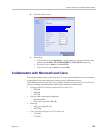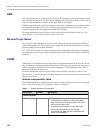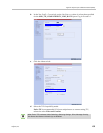
Appendix I-Polycom Open Collaboration Network (POCN)
Polycom, Inc. I-35
Resource Allocation
The MCU media processor (ART) supports up to three TIP-enabled screens as follows:
• One TIP-enabled endpoint with three screens
• Up to three TIP-enabled endpoint with one screen
TIP-enabled endpoint with three screens must be handled by the same media processor.
This endpoint may fail to connect if there is no one fully free media (ART) processor
available.
The MCU will always try to fill up one media processor with up to three TIP-enabled
endpoint with one screen, to save free media processors for TIP-enabled endpoint with three
screens.
When monitoring an ongoing Telepresence conference with TIP-enabled endpoints (Cisco
and Polycom), virtual participants are used to indicate the additional screens in the in the
Web Client. For example, if the endpoint has three screens, the system will display three
participants, one for each screen.
An additional virtual Audio Only participant is used for the audio only telephone
connected to the TIP endpoint.
System capacity per MPMx card and resolution is summarized in the following table:
Configuring the Microsoft, Cisco and Polycom
Components
1 Configure a SIP Trunk connection between the Polycom DMA system and the Cisco
Unified Communications Manager (CUCM).
For more information see the Polycom Unified Communications Deployment Guide for Cisco
Environments, “Using a Polycom DMA System as SIP Peer”.
2 Register the Collaboration Server to the Lync Server
a Install a Security Certificate on the Collaboration Server.
The Certificate is obtained from the System Administrator and saved on the
Workstation.
963kbps to 3Mb 720p 30 fps
Up to 936kbps Call is disconnected.
Table I-3 MPMx Resolution Capacities
No. of media
processors
(ART) per card
No. of TIP
screens per
media processor
720p30 ports 1080p30 ports
10 3 30 15
Table I-2 Supported resolution per conference line rate
Conference Line Rate Selected Resolution


















